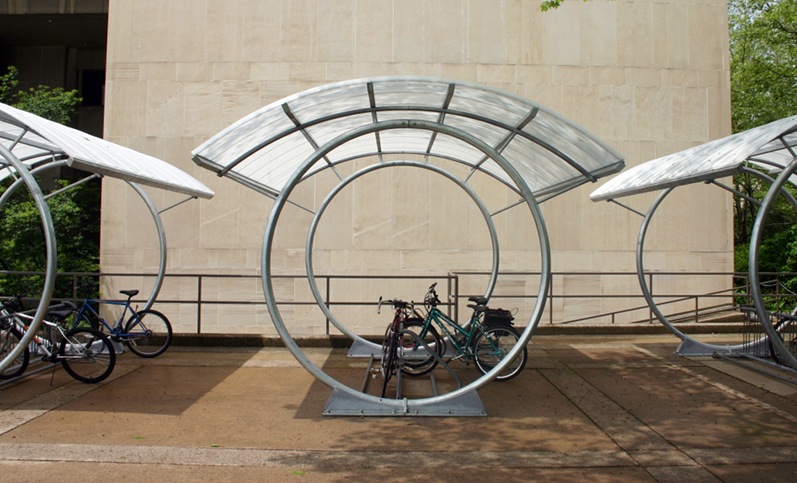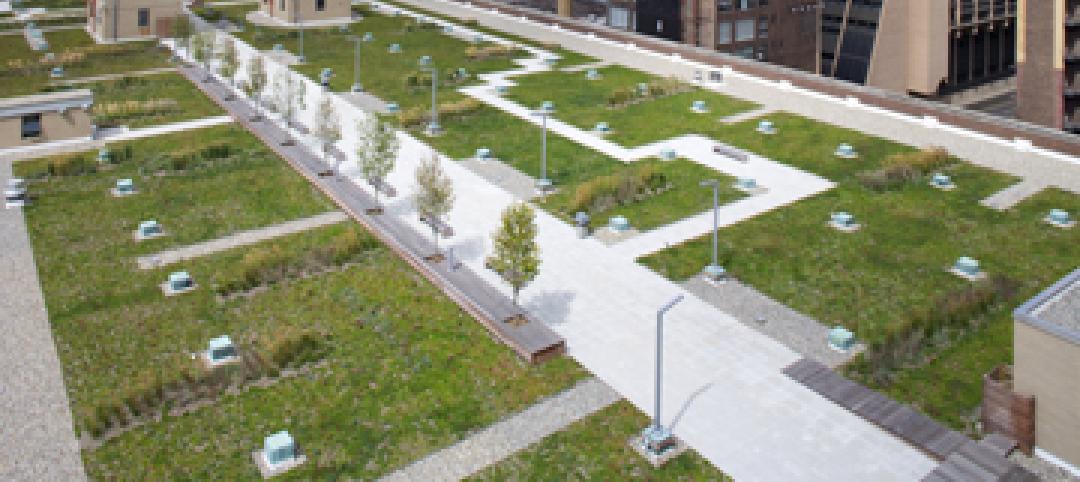Every year, BuildingGreen names the ten best green building products that, as the publication states, “transform the design and construction industry” by helping to solve environmental problems, from reducing greenhouse gas emissions to finding durable and safe materials.
A urinal, bike rack, ventless dryer, and a chair made of mushroom roots made the cut. For more on this year’s list, click here. Here are the 2014 and 2015 editions.
Honeywell’s Solstice Liquid Blowing Agent — Based on hydrofluoroolefin technology, it replaces a high global warming potential blowing agent, HFC-245fa, found in spray polyurethane foam. Solstice has a 100-year GWP of 1, which means it is equal to carbon dioxide in terms of global warming potential. The product is used by Whirlpool in appliance lines, as well as for Lapolla’s Foam-Lok 2000 4G SPF wall insulation, and Henry-West Development Group’s 3012-EB-3 SPF roof insulation.
Whirlpool HybridCare Ventless Clothes Dryer — The ventless heat-pump dryer improves efficiency by using a refrigeration loop that condenses moisture from the drum and returns excess heat energy. HybridCare saves on HVAC energy, providing 40% energy savings over a standard dryer.
Sloan Hybrid Urinal — The urinal uses a water-free cartridge and automatic rinser to keep it clean and odor-free. The unit’s Velocity cartridge pumps liquid through it and out the drainpipe, lessening buildup, while a water solution called Jetrinse is flushed every 72 hours to keep solids from forming in the housing and drain line.
Gunlocke Savor Guest Chair with Ecovative MycoBoard Backing — This guest chair is made from an engineered-wood alternative made from mushroom mycelium, a root, and is as strong and stable as a standard plywood- or particleboard-backed chair.
Duo-Gard Bike Racks and Shelters — The racks can be incorporated into a building to help it achieve LEED status. The shelters’ roofs are made of standing-seam metal or polycarbonate, and walls are made of polycarbonate, safety glass, perforated metal, or steel or aluminum mesh. Photovoltaic panels and LED lighting can also be included.
NuLED Power over Ethernet (PoE) Low-Voltage LED Lighting — The system uses DC power from a standard PoE network, and it can monitor and control LED power consumption and color temperature, all with less energy loss than AC systems.
Personal Comfort Systems Hyperchair — When HVAC systems can’t accommodate everyone’s preferred indoor temperature, this office chair provides personal heating and cooling powered by a lithium ion phosphate battery and controlled by a panel on chair’s arm.
Unity Homes High-Performance Panelized Homes — The high-performance panelized home system uses computer numeric control equipment to help create panelized wall systems and small prefab room modules to minimize thermal bridging. Unity Homes use energy-saving insulation and FSC-certified wood with low-VOC finishes.
Sanden Heat Pump Water Heater with CO2 Refrigerant — This heat-pump water heater uses CO2 as a refrigerant and creates water temperatures high enough for hydronic heating. It can deliver around 16,000 Btu/hr and can produce 149°F water.
Tesla Powerwall and Powerpack Onsite Energy Storage — The rechargeable lithium-ion battery system incorporates liquid thermal management, battery management, and a DC–DC converter. It has a 10 kWh unit optimized for weekly or backup use and a 7 kWh unit for daily use.
 Tesla’s Powerwall and Powerpack. Photo: Tesla (via BuildingGreen).
Tesla’s Powerwall and Powerpack. Photo: Tesla (via BuildingGreen).
Related Stories
| Sep 12, 2011
Putting a stamp on USPS's first green roof
The Morgan Building roof totals 150,000-sf. In addition to a vegetated green roof, other roof areas were upgraded and included 55,000-sf of reflective concrete pavers and ballast, which were also placed over a Sarnafil waterproofing membrane, and 40,000-sf of EnergySmart Roof—a reflective, energy-efficient vinyl roofing system from Sika Sarnafil.
| May 18, 2011
Carnegie Hall vaults into the 21st century with a $200 million renovation
Historic Carnegie Hall in New York City is in the midst of a major $200 million renovation that will bring the building up to contemporary standards, increase educational and backstage space, and target LEED Silver.
| May 16, 2011
Seattle unveils program to boost building efficiency
Seattle launched a new program that will help commercial property owners and managers assess and improve building energy efficiency. Under the program, all commercial and multifamily buildings larger than 10,000 sq. ft. will be measured for their energy performance using the EPA’s ENERGY STAR Portfolio Manager.
| May 10, 2011
Are green goals out of reach for federal buildings?
Many federal agencies are struggling to convert their existing buildings to meet green standards, according to the Office of Management and Budget. Of 20 agencies graded by the OMB on their compliance with green mandates, only seven met the 2010 mandate that requires at least 5% of their buildings meet energy-efficient and sustainable standards.
| Apr 14, 2011
U.S. embassies on a mission to green the world's buildings
The U.S. is putting greater emphasis on greening its worldwide portfolio of embassies. The U.S. State Department-affiliated League of Green Embassies already has 70 U.S. embassies undergoing efforts to reduce their environmental impact, and the organization plans to increase that number to more than 100 by the end of the year.
| Feb 7, 2011
GSA Unveils New Sustainable Workplace Design Tool
The U.S. General Services Administration launched its Sustainable Facilities Tool on Monday, Feb. 7. The innovative online tool will make it easier for both government and private-sector property managers and developers to learn about and evaluate strategies to make workplaces more sustainable, helping to build and create jobs in America’s clean energy economy of the future.
| Feb 4, 2011
U.S. Green Building Council applauds President Obama’s Green Building Initiative
The U.S. Green Building Council applauded a key element of President Obama’s plan to “win the future” by making America’s commercial buildings more energy- and resource-efficient over the next decade. The President’s plan, entitled Better Buildings Initiative, catalyzes private-sector investment through a series of incentives to upgrade offices, stores, schools and universities, hospitals and other commercial and municipal buildings.
| Feb 4, 2011
President Obama: 20% improvement in energy efficiency will save $40 billion
President Obama’s Better Buildings Initiative, announced February 3, 2011, aims to achieve a 20% improvement in energy efficiency in commercial buildings by 2020, improvements that will save American businesses $40 billion a year.












